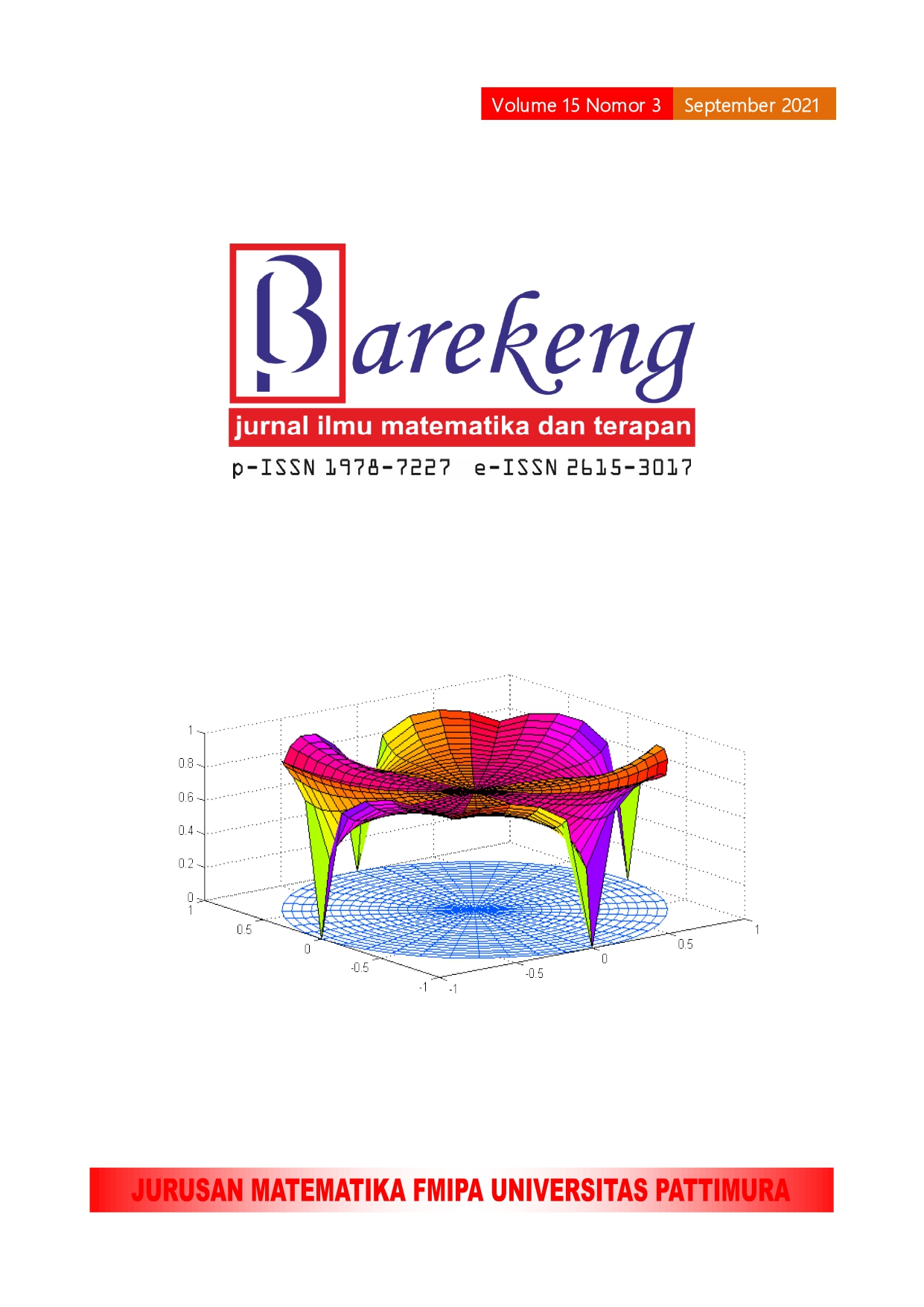ANALISIS ASURANSI PENGANGGURAN DENGAN ASUMSI NON-ZERO MORTALITY
Abstract
Indonesia dengan jumlah penduduk sekitar 267 juta jiwa memiliki angkatan kerja sangat besar. Tetapi jumlah lapangan kerja yang tersedia tidak mampu menyerap semua angkatan kerja ini. Selain itu angka pemutusan hubungan kerja juga relatif masih tinggi. Hal ini membuat pemerintah melontarkan wacana program asuransi pengangguran. Sejauh ini telah dilakukan studi tentang hubungan besar premi dan benefit dari asuransi pengangguran. Tetapi, model yang digunakan dalam perhitungan preminya, dibentuk berdasarkan asumsi zero mortality. Tujuan dari penelitian ini adalah menganalis asuransi pengangguran dengan asumsi non-zero mortality. Metode yang digunakan adalah The Equivalence Principle. Hasil Perhitungan menunjukkan tarif premi untuk non-zero mortality nilainya lebih kecil dari pada tarif premi untuk zero mortality.
Downloads
References
Badan Pusat Statistik , Statistik Indonesia, BPS, 20 Desember 2020, [Online]. Tersedia: https://www.bps.go.id/ [Diakses 8 Desember 2020].
Biro Pusat Aktuaria , “TMT 2012 Tabel Mortalita Taspen 2012,†Aktuaria, 20 Juli 2012 [Online]. Tersedia:
http://docshare04.docshare.tips/files/21195/211956752.pdf [Diakses: 20 Desember 2020].
BPJS Ketenagakerjaan, “Laporan tahunan 2017,†Bpjsketenakerjaan, 1 Desember 2017, [Online]. Tersedia: www.bpjsketenagakerjaan.go.id [Diakses 8 Mei 2019]
C. Stone and W. Chen, Introduction to Unemployment Insurance, Cbpp 30 Juli 2014. [Online]. Tersedia: https://www.cbpp.org/research/introduction-to-unemployment-insurance
D.C.M Dickson., M.R. Hardy. & H.R. Waters, Actuarial Mathematics for Life Contingent Risk. New York: Cambridge University Press, 2013.
G.J Hwang (2019), How fair are unemployment benefits? The experience of East Asia. Wiley, 29 April 2019, [Online]. Tersedia: https://doi.org/10.1111/issr.12202
H.L. Chuang and M.T. Yu, “Pricing Unemployment Insurance-An Umployment-Duration-Adjusted Approach,†ASTIN Bulletin, vol. 40, Issue 2, pp. 519-545, 2010.
H.U. Gerber Gerber, Life Insurance Mathematics, 3rd edition. Berlin: Springer, 1997
International Labour Organization 2003, The Feasibility of Introducing an Unemployment Insurance Benefit in Indonesia, Ilo, 30 Desember 2003, [Online]. Tersedia: https://www.ilo.org [Diakses pada tanggal 8 Agustus 2020].
I. N. Widana dan K. Jayanegara , “Analisis Premi dari Asuransi Pengangguran,†Jurnal Matematika, vol 9 no. 1 pp. 60-65, 2019
S L. Gajek and K.M. Ostaszewski, Financial Risk Management for Pension Plans. Amsterdam: Elsevier, 2004
M.M. Kithinji, R.O. Simwa, and J.A.M. Otieno “Pricing Unemployment Insurance Assuming Burr Xii Mixture Distribution To Model Unemployment,†International Journal of Statistical Distributions andApplications, vol. 2, No 3, pp. 27-34, 2016.
N.L. Bowers, H.U. Gerber, J.C. Hickman, D.A. Jones, and C.J. Nesbitt, Actuarial Mathematics, 2nd edition. Schaumburg: The Society of Actuaries, 2017.
R.O. Simwa, “On Pricing of Unemployment Insurance Assuming Non-Zero Mortality for Employees with Application to the USA,†European Journal of Statistics and Probability, vol. 6, No. 2, pp. 1-11, 2018.
S.U. Adillah, “Kebijakan Jaminan Sosial Tenaga Kerja Sektor Informal Berbasis Keadilan Sosial untuk Meningkatkan Kesejahteraan ,†Yustisia, vol 4 no. 3, pp. 558-580, 2015
Z. Ragiliawan dan B.T. Gunawan, “Kehilangan Pekerjaan (JKP) dalam Perspektif Belanja Negaraâ€, Jurnal Ketenagakerjaan, vol. 15, No 1, pp. 48-60, 2021.
Authors who publish with this Journal agree to the following terms:
- Author retain copyright and grant the journal right of first publication with the work simultaneously licensed under a creative commons attribution license that allow others to share the work within an acknowledgement of the work’s authorship and initial publication of this journal.
- Authors are able to enter into separate, additional contractual arrangement for the non-exclusive distribution of the journal’s published version of the work (e.g. acknowledgement of its initial publication in this journal).
- Authors are permitted and encouraged to post their work online (e.g. in institutional repositories or on their websites) prior to and during the submission process, as it can lead to productive exchanges, as well as earlier and greater citation of published works.






1.gif)



